Techno-Economic Assessment of Green Hydrogen Production by an Off-Grid Photovoltaic Energy System
Abstract
1. Introduction
1.1. Hydrogen Production from Water
1.2. Literature Review
1.3. Objective and Structure
2. Proposed System and Site of Investigation
3. Experimental Environmental Data
4. Modeling and Governing Equations
4.1. Model of PV Array
4.2. Model for Electrolyzer
4.3. Model for Compressor and Hydrogen Tank
4.4. Model for Converter
4.5. System Power Flow
4.6. Hydrogen Cost
5. Results and Discussions
5.1. Power Generation and Energy Production by the Photovoltaic Arrays
5.2. Daily Electrolyzer Energy Consumption and Hydrogen Production
5.3. Monthly Electrolyzer Energy Consumption and Hydrogen Production
5.4. Annual Electrolyzer Energy Consumption and Hydrogen Production
5.5. Annual Hydrogen Production and Cost
6. Conclusions
- For a 2 kW electrolyzer capacity, the annual energy consumption was 7526.39 kWh, and the annual hydrogen production was 183.27 kg at the cost of USD 5.39/kg.
- For a 4 kW electrolyzer capacity, the annual energy consumption was 12,917.96 kWh, and the annual hydrogen production was 315.12 kg at USD 4.48/kg.
- For a 6 kW electrolyzer capacity, the annual energy consumption was 16,382.28 kWh, and the annual hydrogen production was 400.56 kg at USD 4.02/kg.
- For an 8 kW electrolyzer capacity, the annual energy consumption was 18,358.13 kWh, and the annual hydrogen production was 450.14 kg at USD 3.23/kg.
- For a 10 kW electrolyzer capacity, the annual energy consumption was 18,822.98 kWh, and the annual hydrogen production was 463.33 kg at USD 3.68/kg.
- For a 12 kW electrolyzer capacity, the annual energy consumption was 18,793.11 kWh, and the annual hydrogen production was 464.6 kg at USD 3.72/kg.
- For a 14 kW electrolyzer capacity, the annual energy consumption was 18,754.8 kWh, and the annual hydrogen production was 465.68 kg at USD 3.95/kg.
Author Contributions
Funding
Data Availability Statement
Conflicts of Interest
Abbreviations
| AC | Alternative Current |
| DC | Direct Current |
| NOCT | Nominal Operation Cell Temperature |
| PV | Photovoltaic |
| STC | Standard Test Conditions |
| STP | Standard Temperature and Pressure |
| WT | Wind Turbines |
List of Symbols
| AE, BE | Coefficient of the consumption curve (kW/kg/h) |
| F | Faraday constant |
| fPV | PV reduction factor |
| g | Polytrophic coefficient |
| hf | Faraday efficiency |
| hhtc | Hydrogen tank compressor efficiency |
| Ht | Amount of hydrogen produced per year in kilograms. |
| i | Discount rate |
| I | Initial investment cost |
| Ie | Electrolyzer current |
| IE | Electrolyzer current |
| MC | Operation and maintenance cost in (USD) |
| mH2 | Nominal hydrogen mass flow (kg/h) |
| n | Project lifetime |
| NC | Number of cells in series |
| Phti | Hydrogen tank inlet pressure |
| Phto | Hydrogen tank outlet pressure |
| Picon | Converter input power |
| Pocon | Converter output power |
| QH2 | Rate of hydrogen generated by the electrolyzer |
| R | Gas constant |
| SSTC | Incident solar radiation at standard test conditions (kW/m2) |
| ST | Incident solar radiation (kW/m2) |
| ST,NOCT | Incident solar radiation which NOCT (1 kW/m2) |
| t | Time in the year |
| TA | Ambient temperature (°C) |
| TA,NOCT | Temperature at which NOCT (25 °C) |
| TC | Temperature of the PV (°C) |
| TC,NOCT | Cell temperature at which NOCT |
| Thtci | Hydrogen tank compressor inlet temperature |
| Ts | Temperature of the PV under standard test conditions (25 °C) |
| UL | Coefficient of heat transfer to the surrounding |
| Vh tan Κ | Volume of hydrogen tank |
| Y PV | Nominal capacity of PV |
| αP | Temperature coefficient of power (%/°C) |
| ηC | Efficiency of PV |
| ηh tan Κ | Efficiency of hydrogen tank |
| γ | PV module azimuth angle |
| β | PV module tilt angle |
References
- Aydin, M.I.; Dincer, I.; Ha, H. Development of Oshawa hydrogen hub in Canada: A case study. Int. J. Hydrogen Energy 2021, 46, 23997–24010. [Google Scholar] [CrossRef]
- Razmjoo, A.; Kaigutha, L.G.; Rad, M.V.; Marzband, M.; Davarpanah, A.; Denai, M. A Technical analysis investigating energy sustainability utilizing reliable renewable energy sources to reduce CO2 emissions in a high potential area. Renew. Energy 2021, 164, 46–57. [Google Scholar] [CrossRef]
- Barhoumi, E.M.; Okonkwo, P.C.; Zghaibeh, M.; Belgacem, I.B.; Alkanhal, T.A.; Abo-Khalil, A.G.; Tlili, I. Renewable energy resources and workforce case study Saudi Arabia: Review and recommendations. J. Therm. Anal. Calorim. 2020, 141, 221–230. [Google Scholar] [CrossRef]
- Hassan, Q. Evaluation and optimization of off-grid and on-grid photovoltaic power system for typical household electrification. Renew. Energy 2021, 164, 375–390. [Google Scholar] [CrossRef]
- Gielen, D.; Gorini, R.; Leme, R.; Prakash, G.; Wagner, N.; Janeiro, L.; Collins, S.; Kadir, M.; Asmelash, E.; Ferroukhi, R.; et al. World Energy Transitions Outlook: 1.5 °C Pathway; International Renewable Energy Agency: Abu Dhabi, United Arab Emirates, 2021; Available online: https://www.irena.org/publications/2021/Jun/World-Energy-Transitions-Outlook (accessed on 25 October 2022).
- Wu, Y.; Deng, Z.; Tao, Y.; Wang, L.; Liu, F.; Zhou, J. Site selection decision framework for photovoltaic hydrogen production project using BWM-CRITIC-MABAC: A case study in Zhangjiakou. J. Clean. Prod. 2021, 324, 129233. [Google Scholar] [CrossRef]
- Hassan, Q.; Jaszczur, M.; Hafedh, S.A.; Abbas, M.K.; Abdulateef, A.M.; Hasan, A.; Abdulateef, J.; Mohamad, A. Optimizing a microgrid photovoltaic-fuel cell energy system at the highest renewable fraction. Int. J. Hydrogen Energy 2022, 47, 13710–13731. [Google Scholar] [CrossRef]
- Simoes, S.G.; Catarino, J.; Picado, A.; Lopes, T.F.; di Berardino, S.; Amorim, F.; Gírio, F.; Rangel, C.; de Leão, T.P. Water availability and water usage solutions for electrolysis in hydrogen production. J. Clean. Prod. 2021, 315, 128124. [Google Scholar] [CrossRef]
- Hydrogen Council. Path to Hydrogen Competitiveness: A Cost Perspective; IGEM: Derby, UK, 2020. [Google Scholar]
- Dos Santos, K.G.; Eckert, C.T.; De Rossi, E.; Bariccatti, R.A.; Frigo, E.P.; Lindino, C.A.; Alves, H.J. Hydrogen production in the electrolysis of water in Brazil, a review. Renew. Sustain. Energy Rev. 2017, 68, 563–571. [Google Scholar] [CrossRef]
- Rand, D.A.J.; Dell, R.M. Hydrogen Energy: Challenges and Prospects; Royal Society of Chemistry: London, UK, 2007. [Google Scholar]
- Awasthi, A.; Scott, K.; Basu, S. Dynamic modeling and simulation of a proton exchange membrane electrolyzer for hydrogen production. Int. J. Hydrogen Energy 2011, 36, 14779–14786. [Google Scholar] [CrossRef]
- Han, B.; Steen, S.M., III; Mo, J.; Zhang, F.Y. Electrochemical performance modeling of a proton exchange membrane electrolyzer cell for hydrogen energy. Int. J. Hydrogen Energy 2015, 40, 7006–7016. [Google Scholar] [CrossRef]
- Görgün, H. Dynamic modelling of a proton exchange membrane (PEM) electrolyzer. Int. J. Hydrogen Energy 2006, 31, 29–38. [Google Scholar] [CrossRef]
- Acar, C.; Dincer, I.; Naterer, G.F. Review of photocatalytic water-splitting methods for sustainable hydrogen production. Int. J. Energy Res. 2016, 40, 1449–1473. [Google Scholar] [CrossRef]
- Chatterjee, P.; Ambati, M.S.K.; Chakraborty, A.K.; Chakrabortty, S.; Biring, S.; Ramakrishna, S.; Wong, T.K.S.; Kumar, A.; Lawaniya, R.; Dalapati, G.K. Photovoltaic/photo-electrocatalysis integration for green hydrogen: A review. Energy Convers. Manag. 2022, 261, 115648. [Google Scholar]
- Grimm, A.; de Jong, W.A.; Kramer, G.J. Renewable hydrogen production: A techno-economic comparison of photoelectrochemical cells and photovoltaic-electrolysis. Int. J. Hydrogen Energy 2020, 45, 22545–22555. [Google Scholar] [CrossRef]
- Olivier, P.; Bourasseau, C.; Bouamama, P.B. Low-temperature electrolysis system modelling: A review. Renew. Sustain. Energy Rev. 2017, 78, 280–300. [Google Scholar] [CrossRef]
- Gibson, T.L.; Kelly, N.A. Optimization of solar powered hydrogen production using photovoltaic electrolysis devices. Int. J. Hydrogen Energy 2008, 33, 5931–5940. [Google Scholar] [CrossRef]
- Clarke, R.E.; Giddey, S.; Ciacchi, F.T.; Badwal, S.P.S.; Paul, B.; Andrews, J. Direct coupling of an electrolyser to a solar PV system for generating hydrogen. Int. J. Hydrogen Energy 2009, 34, 2531–2542. [Google Scholar] [CrossRef]
- Bhattacharyya, R.; Misra, A.; Sandeep, K.C. Photovoltaic solar energy conversion for hydrogen production by alkaline water electrolysis: Conceptual design and analysis. Energy Convers. Manag. 2017, 133, 1–13. [Google Scholar] [CrossRef]
- Qureshy, A.M.; Dincer, I. Energy and exergy analyses of an integrated renewable energy system for hydrogen production. Energy 2020, 204, 117945. [Google Scholar] [CrossRef]
- Beck, F.J. Rational Integration of Photovoltaics for Solar Hydrogen Generation. ACS Appl. Energy Mater. 2019, 2, 6395–6403. [Google Scholar] [CrossRef]
- Varadhan, P.; Fu, H.C.; Kao, Y.C.; Horng, R.H.; He, J.H. An efficient and stable photoelectrochemical system with 9% solar-to-hydrogen conversion efficiency via InGaP/GaAs double junction. Nat. Commun. 2019, 10, 5282. [Google Scholar] [CrossRef] [PubMed]
- Grimm, A.; Sainte-Marie, A.; Kramer, G.J.; Gazzani, M. Modeling photovoltaic-electrochemical water splitting devices for the production of hydrogen under real working conditions. Int. J. Hydrogen Energy 2022, 47, 11764–11777. [Google Scholar] [CrossRef]
- Astakhov, O.; Agbo, S.N.; Welter, K.; Smirnov, V.; Rau, U.; Merdzhanova, T. Storage batteries in photovoltaic–electrochemical device for solar hydrogen production. J. Power Sources 2021, 509, 230367. [Google Scholar] [CrossRef]
- Hassan, Q.; Jaszczur, M.; Al-Jiboory, A.K.; Hasan, A.; Mohamad, A. Optimizing of hybrid renewable photovoltaic/wind turbine/super capacitor for improving self-sustainability. Energy Harvest. Syst. 2022, 9, 151–164. [Google Scholar] [CrossRef]
- Giménez, S.; Bisquert, J. Photoelectrochemical Solar Fuel Production. In From Basic Principle to Advanced Devices; Springer: Cham, Switzerland, 2016. [Google Scholar]
- Khouya, A. Levelized costs of energy and hydrogen of wind farms and concentrated photovoltaic thermal systems. A case study in Morocco. Int. J. Hydrogen Energy 2020, 45, 31632–31650. [Google Scholar] [CrossRef]
- Hassani, H.; Zaouche, F.; Rekioua, D.; Belaid, S.; Rekioua, T.; Bacha, S. Feasibility of a standalone photovoltaic/battery system with hydrogen production. J. Energy Storage 2020, 31, 101644. [Google Scholar] [CrossRef]
- Yang, Y.; Ma, C.; Lian, C.; Zhang, Y.; Pang, X. Optimal power reallocation of large-scale grid-connected photovoltaic power station integrated with hydrogen production. J. Clean. Prod. 2021, 298, 126830. [Google Scholar] [CrossRef]
- Abd Elaziz, M.; Senthilraja, S.; Zayed, M.E.; Elsheikh, A.H.; Mostafa, R.R.; Lu, S. A new random vector functional link integrated with mayfly optimization algorithm for performance prediction of solar photovoltaic thermal collector combined with electrolytic hydrogen production system. Appl. Therm. Eng. 2021, 193, 117055. [Google Scholar] [CrossRef]
- Kurşun, B.; Ökten, K. Thermodynamic analysis of a Rankine cycle coupled with a concentrated photovoltaic thermal system for hydrogen production by a proton exchange membrane electrolyzer plant. Int. J. Hydrogen Energy 2019, 44, 22863–22875. [Google Scholar] [CrossRef]
- Nordin, N.D.; Rahman, H.A. Comparison of optimum design, sizing, and economic analysis of standalone photovoltaic/battery without and with hydrogen production systems. Renew. Energy 2019, 141, 107–123. [Google Scholar] [CrossRef]
- World Energy Council; EPRI; PwC. Working Paper, Hydrogen on the Horizon: National Hydrogen Strategies; No. 4184478; World Energy Council: London, UK, 2021. [Google Scholar]
- Li, J.; Gao, C.; Lu, X.; Hoseyni, A. A combined energy system consisting of fuel cell, water electrolyzer and solar technologies to produce hydrogen fuel and electricity. Energy Sources Part A Recovery Util. Environ. Eff. 2022, 44, 1173–1188. [Google Scholar] [CrossRef]
- Temiz, M.; Javani, N. Design and analysis of a combined floating photovoltaic system for electricity and hydrogen production. Int. J. Hydrogen Energy 2020, 45, 3457–3469. [Google Scholar] [CrossRef]
- Berrada, A.; Laasmi, M.A. Technical-economic and socio-political assessment of hydrogen production from solar energy. J. Energy Storage 2021, 44, 103448. [Google Scholar] [CrossRef]
- Akyuz, E.; Coskun, C.; Oktay, Z.U.H.A.L.; Dincer, I. Hydrogen production probability distributions for a PV-electrolyser system. Int. J. Hydrogen Energy 2011, 36, 11292–11299. [Google Scholar] [CrossRef]
- Monocrystalline, Luminous PV Module and Converter. Available online: https://luminous.com/ (accessed on 1 June 2022).
- Electrolyzer. Available online: http://www.geemblue.com/ (accessed on 1 June 2022).
- Compressor and Hydrogen Tank. Available online: https://www.doosan.com/ (accessed on 1 June 2022).
- Hassan, Q.; Abbas, M.K.; Abdulateef, A.M.; Abdulateef, J.; Mohamad, A. Assessment the potential solar energy with the models for optimum tilt angles of maximum solar irradiance for Iraq. Case Stud. Chem. Environ. Eng. 2021, 4, 100140. [Google Scholar] [CrossRef]
- Abbas, M.K.; Hassan, Q.; Jaszczur, M.; Al-Sagar, Z.S.; Hussain, A.N.; Hasan, A.; Mohamad, A. Energy visibility of a modeled photovoltaic/diesel generator set connected to the grid. Energy Harvest. Syst. 2021, 9, 27–38. [Google Scholar] [CrossRef]
- Hassan, Q.; Pawela, B.; Hasan, A.; Jaszczur, M. Optimization of Large-Scale Battery Storage Capacity in Conjunction with Photovoltaic Systems for Maximum Self-Sustainability. Energies 2022, 15, 3845. [Google Scholar] [CrossRef]
- Jaszczur, M.; Hassan, Q.; Al-Anbagi, H.N.; Palej, P. A numerical analysis of a HYBRID PV+ WT power system. E3S Web Conf. 2019, 128, 05001. [Google Scholar] [CrossRef]
- Boulmrharj, S.; Khaidar, M.; Bakhouya, M.; Ouladsine, R.; Siniti, M.; Zine-dine, K. Performance assessment of a hybrid system with hydrogen storage and fuel cell for cogeneration in buildings. Sustainability 2020, 12, 4832. [Google Scholar] [CrossRef]
- Hassan, Q. Assessing of renewable energy for electrical household ancillary based on photovoltaics and wind turbines. IOP Conf. Ser. Mater. Sci. Eng. 2021, 1076, 012006. [Google Scholar] [CrossRef]
- Barhoumi, E.M.; Farhani, S.; Bacha, F. High efficiency power electronic converter for fuel cell system application. Ain Shams Eng. J. 2021, 12, 2655–2664. [Google Scholar] [CrossRef]
- Jaszczur, M.; Hassan, Q.; Abdulateef, A.M.; Abdulateef, J. Assessing the temporal load resolution effect on the photovoltaic energy flows and self-consumption. Renew. Energy 2021, 169, 1077–1090. [Google Scholar] [CrossRef]
- Jaszczur, M.; Hassan, Q.; Palej, P.; Abdulateef, J. Multi-Objective optimisation of a micro-grid hybrid power system for household application. Energy 2020, 202, 117738. [Google Scholar] [CrossRef]
- Okonkwo, P.C.; Ige, O.O.; Barhoumi, E.M.; Uzoma, P.C.; Emori, W.; Benamor, A.; Abdullah, A.M. Platinum degradation mechanisms in proton exchange membrane fuel cell (PEMFC) system: A review. Int. J. Hydrogen Energy 2021, 46, 15850–15865. [Google Scholar] [CrossRef]
- Energy Information Administration Report. Available online: https://www.eia.gov/outlooks/aeo/ (accessed on 1 June 2022).
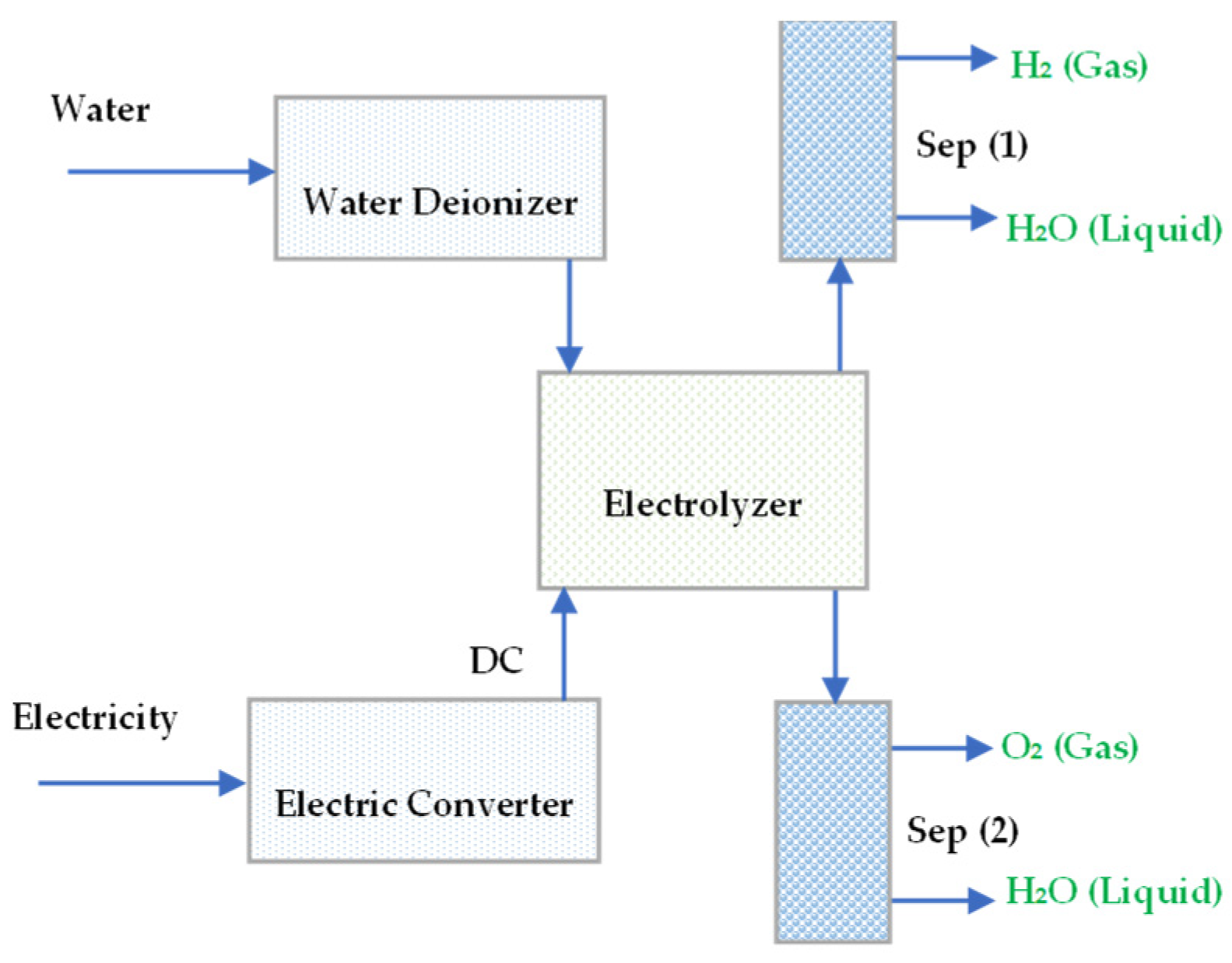

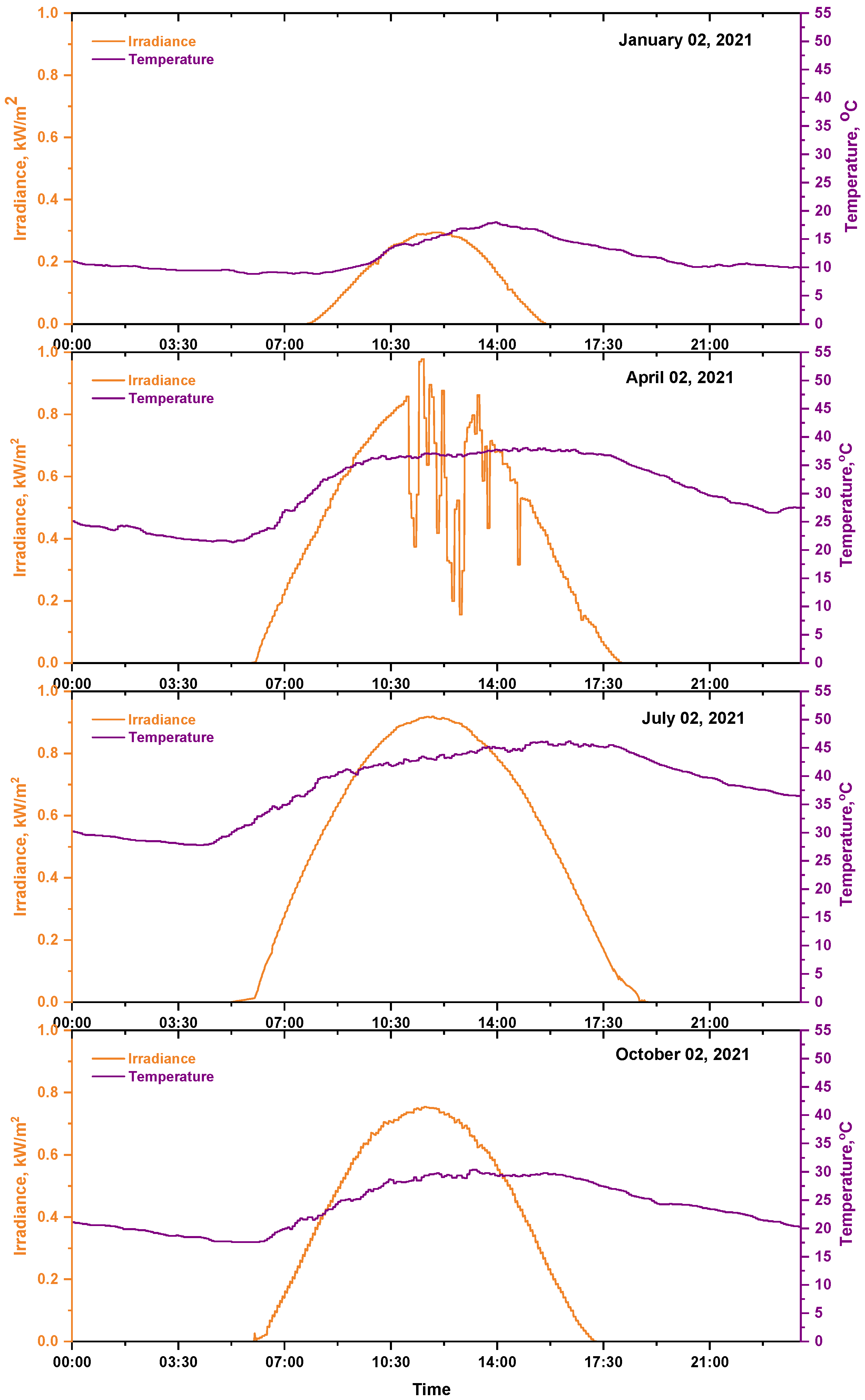
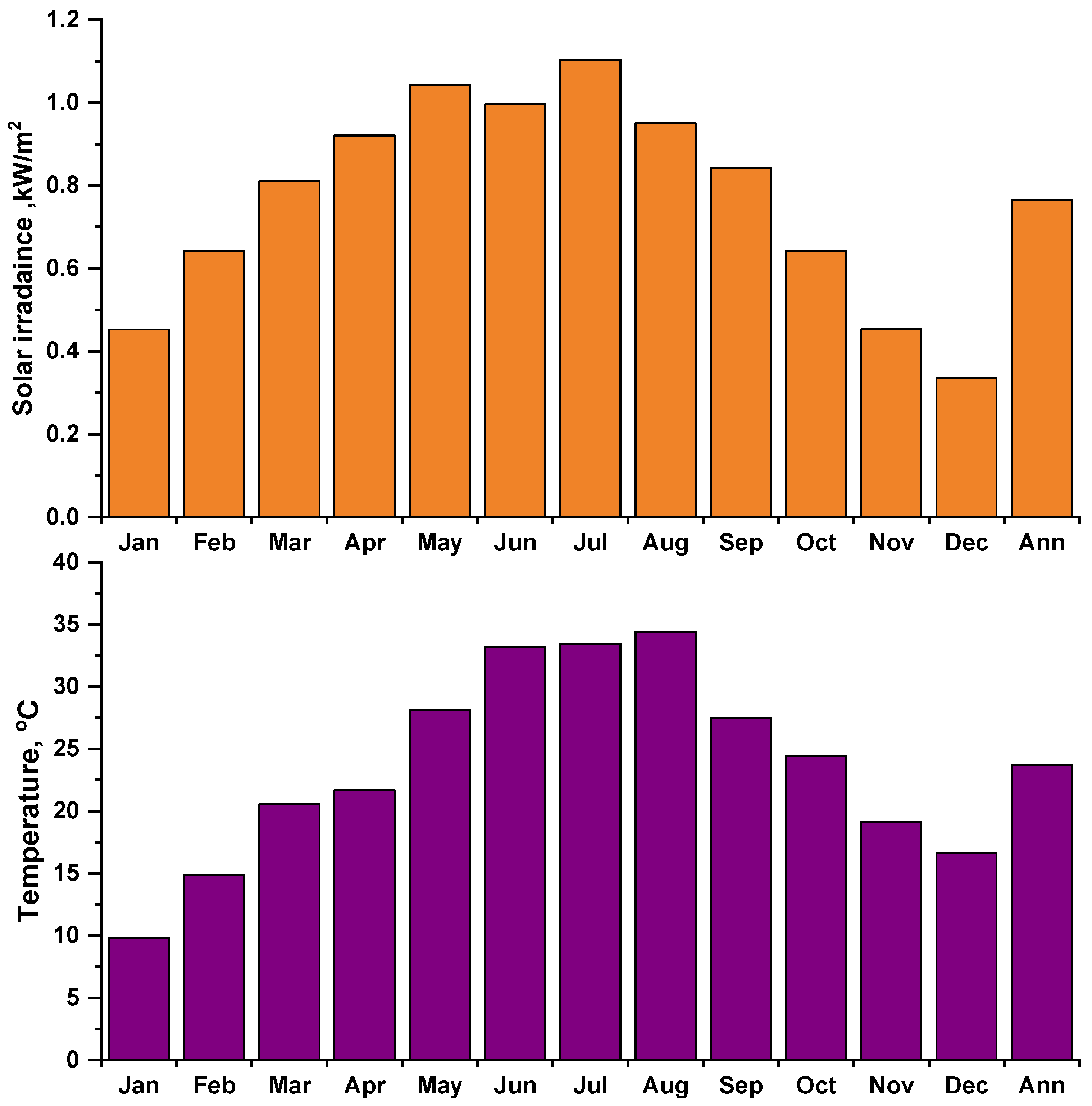
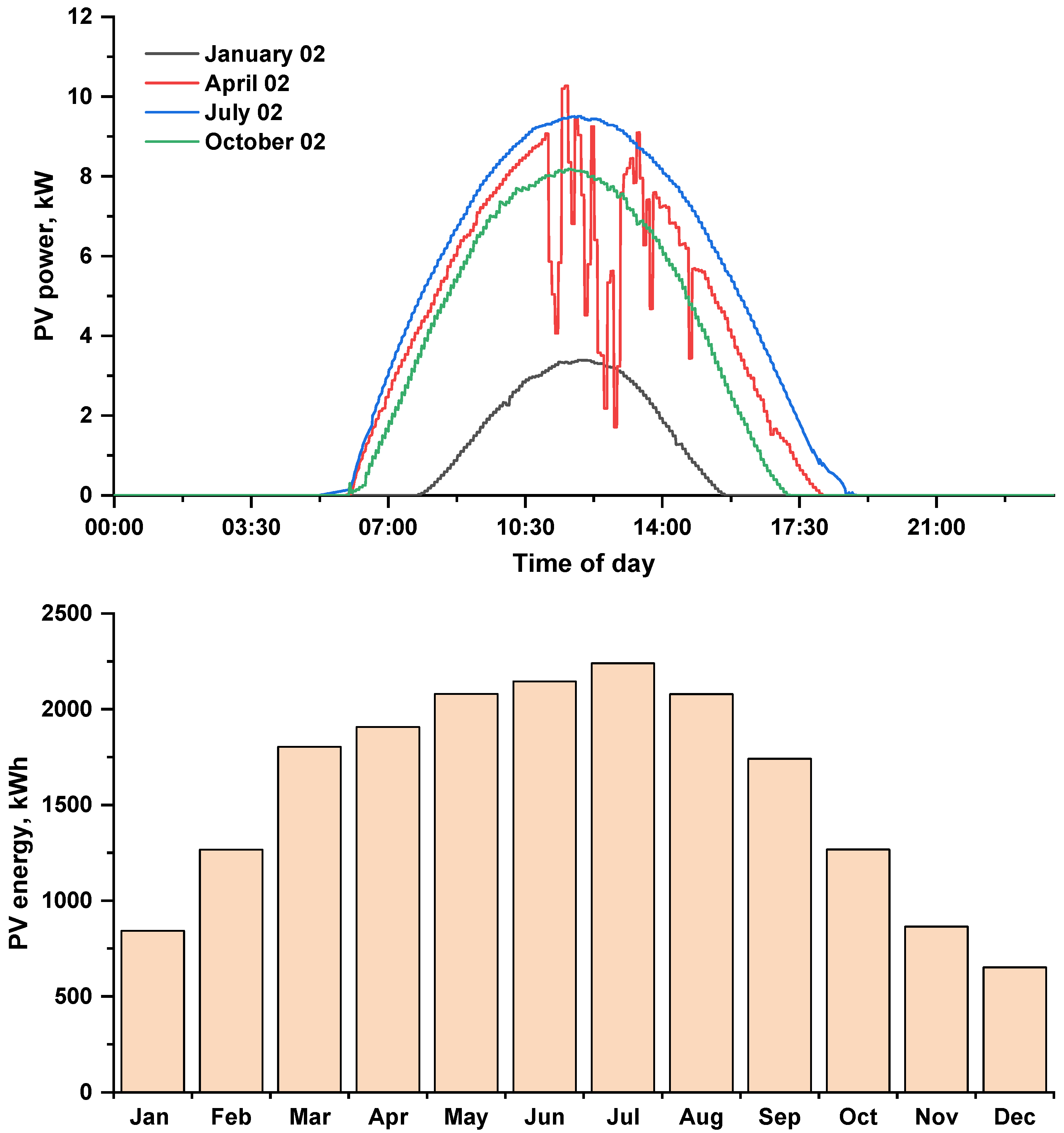
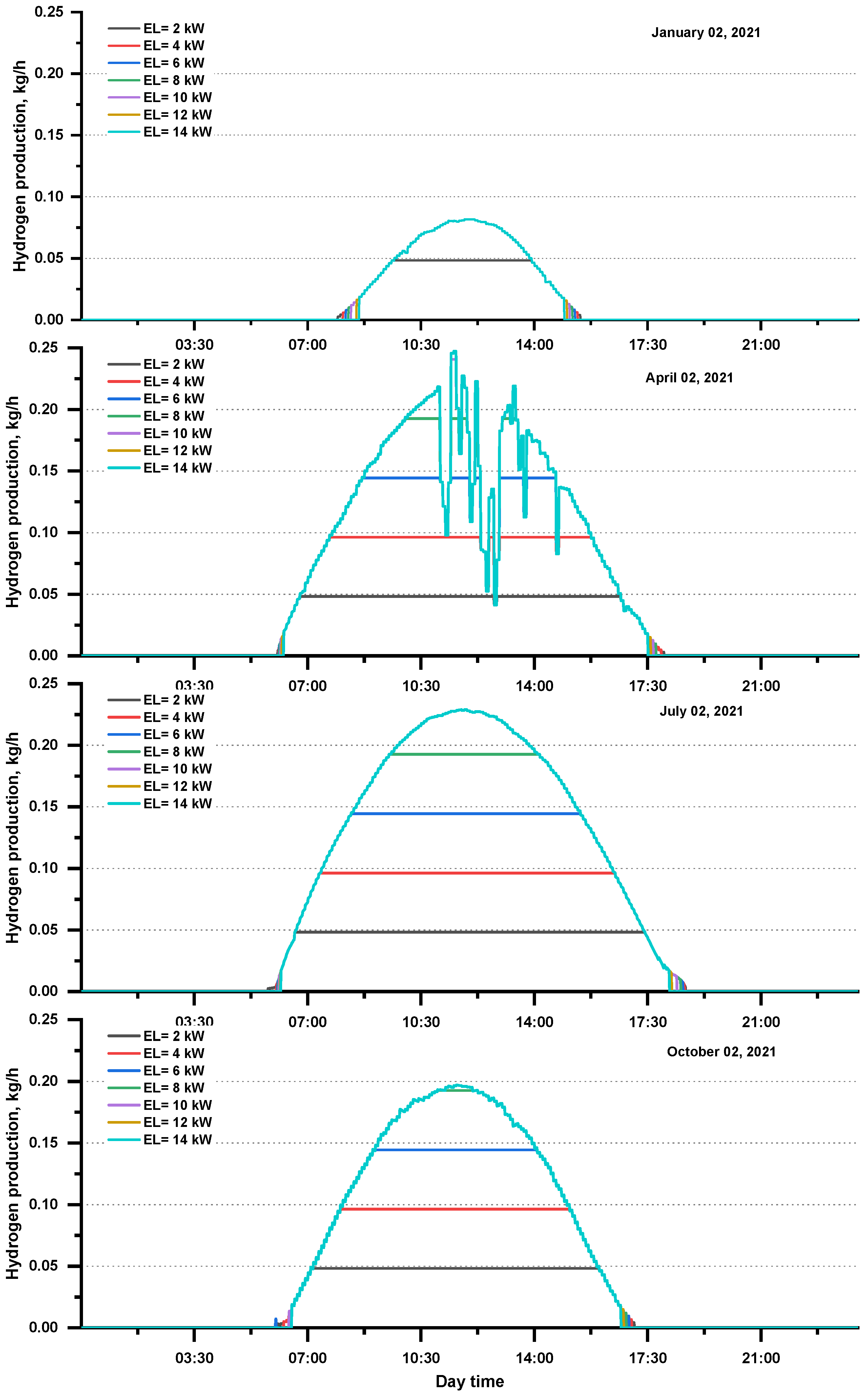


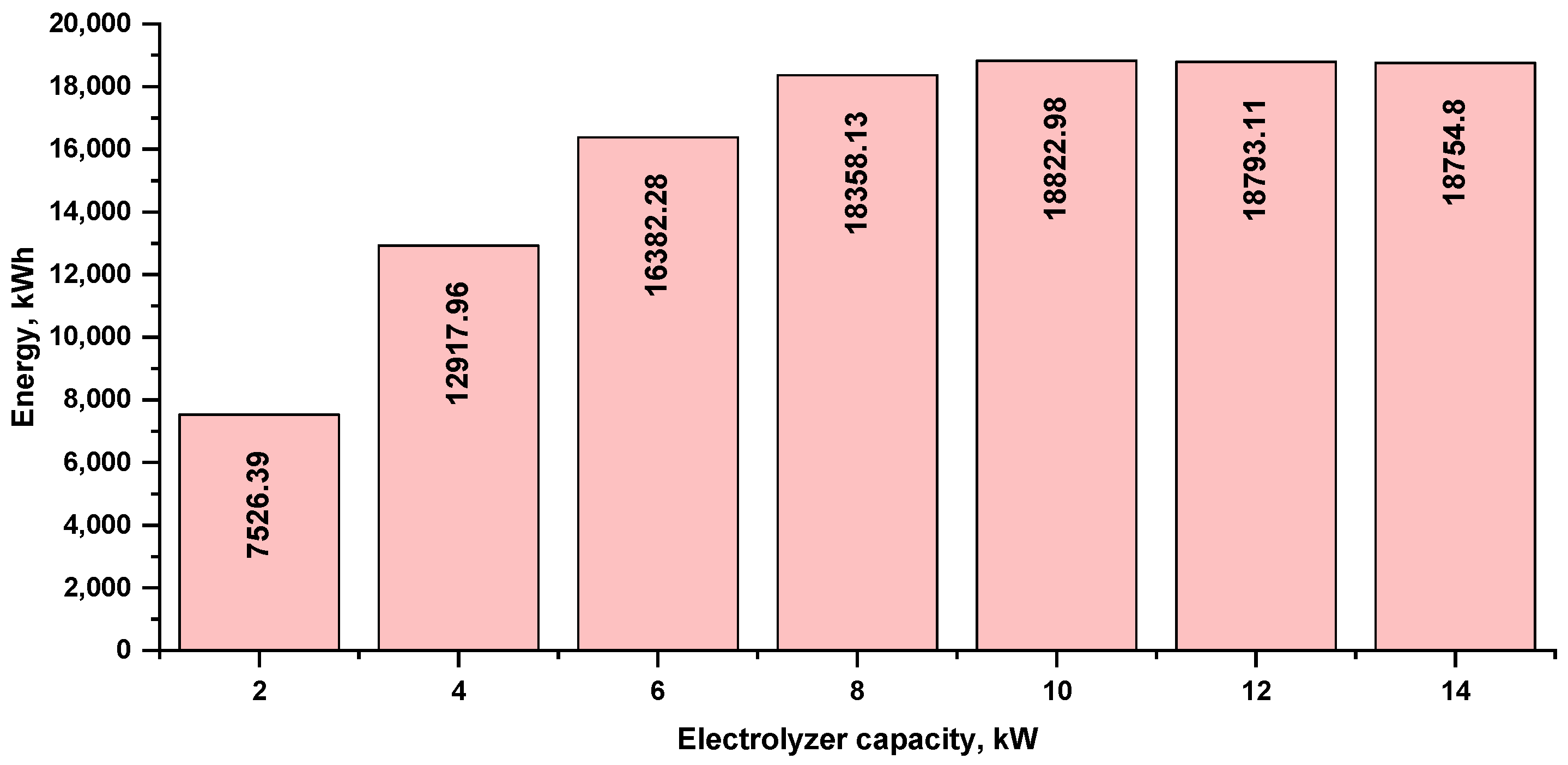
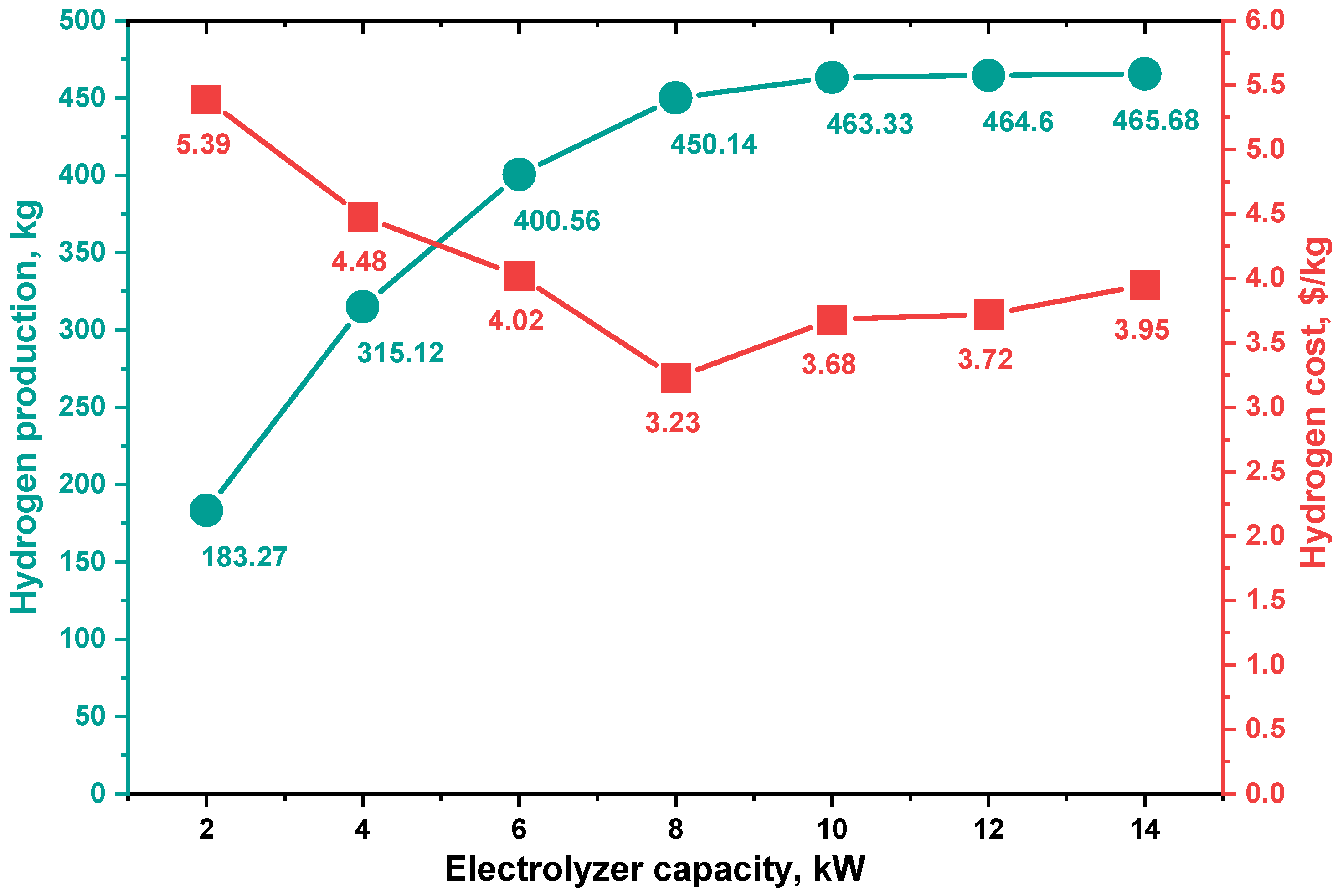
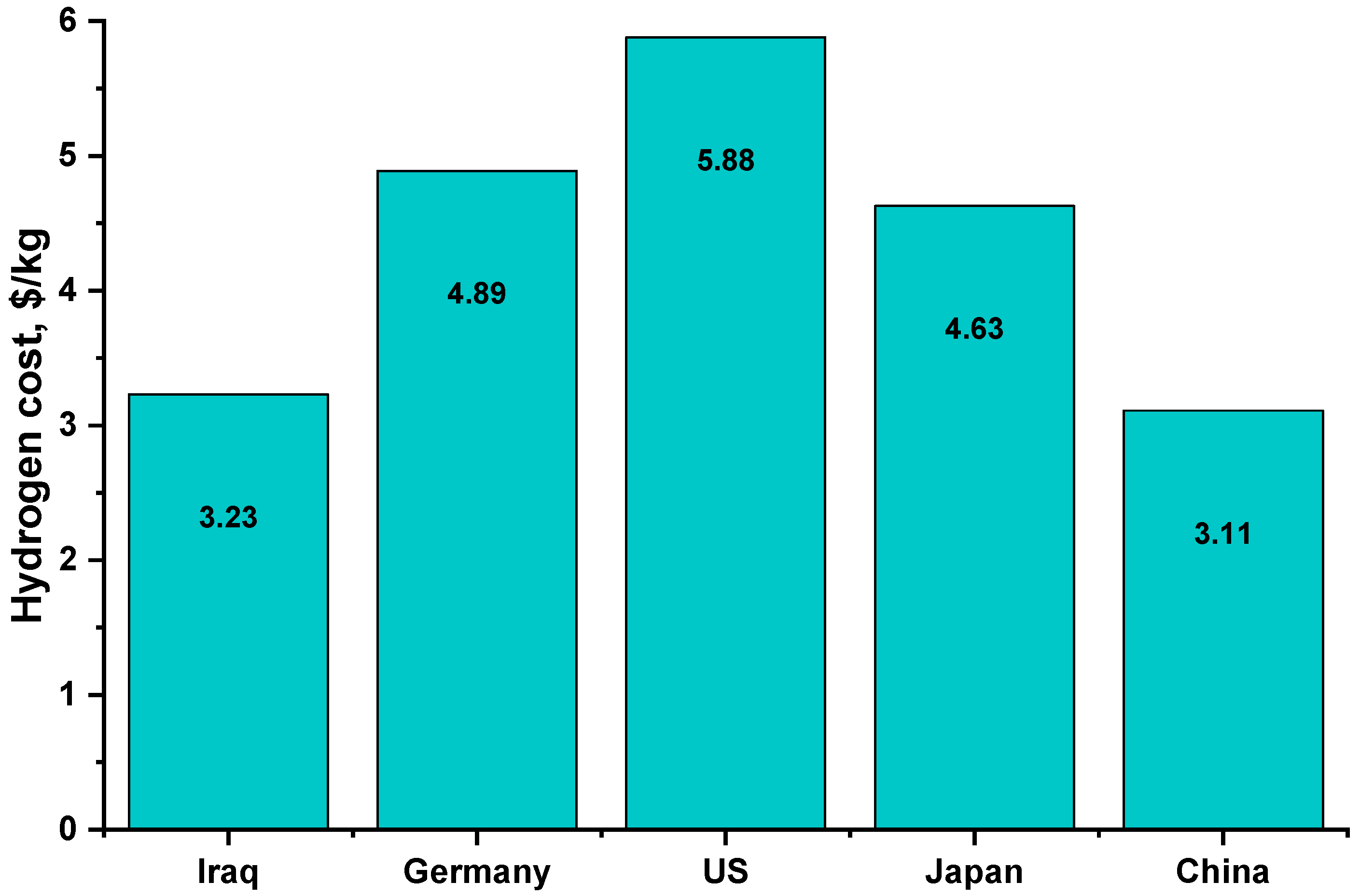
| Component | Model | Rated Power | Efficiency (%) | Capital (USD/Unit) | Replacement (USD/Unit) | Maintenance (USD) | Life Span (Year) | Ref. |
|---|---|---|---|---|---|---|---|---|
| PV module | Luminous | 1 kW | 19.8 | 140 | 140 | 10/year | 20 | [40] |
| Converter | Luminous | 12 kW | >95 | 850 | 900 | 10 | 10 | [40] |
| Electrolyzer | Geemblue | 5 kW | >95 | 700 | 700 | 0.03/hour | 10 | [41] |
| Compressor | Doosan/AC | 0.8 kW | >93 | 180 | 180 | 20 | [42] | |
| Hydrogen tank | Doosan | 20 | 98 | 100 | 100 | 10/year | 25 | [42] |
| Day | Irradiance (kWh/m2) | Temperature (°C) |
|---|---|---|
| 2 January | 1.36 | 11.8 |
| 2 April | 5.62 | 30.7 |
| 2 July | 7.26 | 38.3 |
| 2 October | 5.01 | 23.9 |
| Day | PV Energy (kWh) |
|---|---|
| 2 January | 15.75 |
| 2 April | 60.32 |
| 2 July | 76.02 |
| 2 October | 55.08 |
| Day | 2 kW | 4 kW | 6 kW | 8 kW | 10 kW | 12 kW | 14 kW |
|---|---|---|---|---|---|---|---|
| 2 January | 11.78 | 15.69 | 15.65 | 15.59 | 15.52 | 15.39 | 15.28 |
| 2 April | 21.89 | 39.41 | 51.94 | 58.80 | 60.16 | 60.13 | 60.05 |
| 2 July | 23.45 | 43.34 | 59.57 | 71.37 | 75.82 | 75. 82 | 75. 82 |
| 2 October | 19.75 | 35.64 | 47.80 | 54.81 | 54.89 | 54.85 | 54.79 |
| Day | 2 kW | 4 kW | 6 kW | 8 kW | 10 kW | 12 kW | 14 kW |
|---|---|---|---|---|---|---|---|
| 2 January | 0.28 | 0.37 | 0.37 | 0.37 | 0.37 | 0.37 | 0.36 |
| 2 April | 0.52 | 0.94 | 1.25 | 1.41 | 1.44 | 1.44 | 1.44 |
| 2 July | 0.56 | 1.04 | 1.43 | 1.71 | 1.82 | 1.82 | 1.82 |
| 2 October | 0.47 | 0.858 | 1.15 | 1.32 | 1.32 | 1.32 | 1.31 |
Disclaimer/Publisher’s Note: The statements, opinions and data contained in all publications are solely those of the individual author(s) and contributor(s) and not of MDPI and/or the editor(s). MDPI and/or the editor(s) disclaim responsibility for any injury to people or property resulting from any ideas, methods, instructions or products referred to in the content. |
© 2023 by the authors. Licensee MDPI, Basel, Switzerland. This article is an open access article distributed under the terms and conditions of the Creative Commons Attribution (CC BY) license (https://creativecommons.org/licenses/by/4.0/).
Share and Cite
Hassan, Q.; Abdulrahman, I.S.; Salman, H.M.; Olapade, O.T.; Jaszczur, M. Techno-Economic Assessment of Green Hydrogen Production by an Off-Grid Photovoltaic Energy System. Energies 2023, 16, 744. https://doi.org/10.3390/en16020744
Hassan Q, Abdulrahman IS, Salman HM, Olapade OT, Jaszczur M. Techno-Economic Assessment of Green Hydrogen Production by an Off-Grid Photovoltaic Energy System. Energies. 2023; 16(2):744. https://doi.org/10.3390/en16020744
Chicago/Turabian StyleHassan, Qusay, Imad Saeed Abdulrahman, Hayder M. Salman, Olushola Tomilayo Olapade, and Marek Jaszczur. 2023. "Techno-Economic Assessment of Green Hydrogen Production by an Off-Grid Photovoltaic Energy System" Energies 16, no. 2: 744. https://doi.org/10.3390/en16020744
APA StyleHassan, Q., Abdulrahman, I. S., Salman, H. M., Olapade, O. T., & Jaszczur, M. (2023). Techno-Economic Assessment of Green Hydrogen Production by an Off-Grid Photovoltaic Energy System. Energies, 16(2), 744. https://doi.org/10.3390/en16020744








